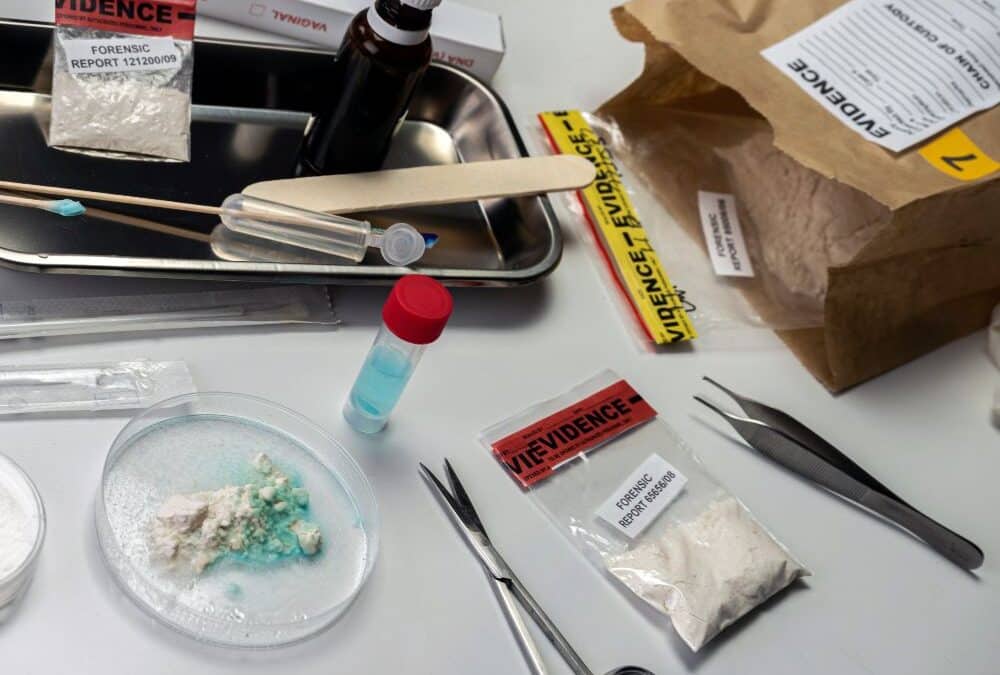Eutylone, scientifically classified as β-Keto-ethylbenzodioxolylbutanamine, belongs to the cathinone family, a group of beta-ketone amphetamines analogous to the naturally occurring khat plant alkaloids. Originating as a research chemical, Eutylone started gaining prominence in the late 2010s, primarily as an ingredient in designer recreational drugs. These drugs, often labeled as “bath salts” or other disguises, are not intended for human consumption, but their psychoactive effects have attracted those seeking alternative stimulants.
The molecular structure of Eutylone closely mirrors that of MDMA (Ecstasy) and methylenedioxypyrovalerone (MDPV). This structural resemblance means that Eutylone can act on the brain’s neurotransmitter systems in ways similar to these drugs, though the exact mechanism of action, potency, and full spectrum of effects differ.
While Eutylone itself is a relatively new compound, the history of synthetic cathinones is extensive. The 1960s saw the first emergence of these synthetics, though the wave of popularity surged around 2009 when they began to be marketed aggressively as legal alternatives to established illicit drugs.
It’s crucial to note that the term “bath salts” in this context doesn’t refer to the products used in bathing. The name was merely a subterfuge to navigate legal restrictions and market the product more discreetly. As with other synthetic drugs, the exact composition of products sold as “bath salts” can vary, making their effects unpredictable and potentially hazardous.
The Chemistry Behind Eutylone
Eutylone is scientifically known as β-Keto-ethylbenzodioxolylbutanamine. This nomenclature, while complex, provides insights into the compound’s chemical structure and behavior.
Molecular Structure:
Eutylone’s molecular formula is C13H17NO3. Structurally, it’s a beta-keto analog of MDMA. This means that while they share a common structural backbone, Eutylone has a ketone group (a carbonyl group bonded to a carbon atom) on its beta-carbon, which differentiates it from MDMA.
Relation to Cathinones:
Cathinones are naturally occurring compounds found in the khat plant (Catha edulis). They are essentially amphetamines with a ketone oxygen atom on the beta carbon. Eutylone, being synthetic, is modeled on this structural framework but with modifications, leading to its unique properties.
Receptor Binding:
While comprehensive receptor-binding profiles for Eutylone are still under investigation, it’s hypothesized that, like other synthetic cathinones, it affects the brain’s dopamine, serotonin, and norepinephrine levels. It works by inhibiting the reuptake of these neurotransmitters, thereby increasing their concentrations in the neural synapse, leading to stimulating and euphoric effects.
Metabolism:
Once ingested, Eutylone, like other synthetic cathinones, undergoes metabolism in the body. The primary metabolic routes involve demethylenation followed by methylation, or reduction of the ketone functional group, leading to various metabolites. These metabolic products can sometimes contribute to the compound’s psychoactive properties or toxicity.
Physical and Chemical Properties:
Eutylone generally appears as crystalline solids and has a molar mass of 235.28 g/mol. As a synthetic cathinone, its solubility, melting point, and other physicochemical characteristics can be influenced by the presence of impurities, which are common in designer drugs. These impurities can also affect its pharmacological and toxicological effects.
Isomers and Analogues:
The structural flexibility of synthetic cathinones means that Eutylone has various positional isomers and analogs. Each of these might exhibit different pharmacological properties.
In the world of organic chemistry, slight modifications can result in vastly different physiological effects. This is what makes Eutylone and its cousins both intriguing for research and challenging from a regulatory and safety perspective.
Eutylone’s Legal Status
Globally, the legal stance on Eutylone varies significantly. Several jurisdictions have placed restrictions or outright bans on its possession and distribution, though some remain in a legal gray area. It is of utmost importance to be aware that the absence of legal restrictions does not necessarily indicate safety.
From 2017 to 2021, the U.S. saw a surge in eutylone’s availability. In the first half of 2017, this synthetic cathinone was found in fewer than ten drug items seized by law enforcement. Flash forward to the same period in 2021, and eutylone was identified in a staggering 8,379 drug items, ranking it seventh in drug identifications. These rapid shifts raised alarms, leading to public alerts about the overdose risks associated with eutylone, especially when mis-sold as MDMA.
Grave Consequences: Eutylone-Involved Deaths
The CDC, through initiatives like the State Unintentional Drug Overdose Reporting System (SUDORS), has been keeping tabs on eutylone’s lethal impact. In 2020 alone, 343 eutylone-related fatalities were reported, with an overwhelming 75.5% of these tragedies concentrated in Florida and Maryland.
Delving into the specifics of these deaths reveals another concerning pattern: the co-existence of other drugs. A majority of eutylone-involved fatalities also involved the presence of illicitly manufactured fentanyls, cocaine, or methamphetamine, amplifying the risks.
Furthermore, among the documented deaths, there were instances where individuals had shown signs of MDMA use or a history of it, but toxicology results for MDMA came back negative. This suggests that these individuals might have unwittingly consumed eutylone, thinking it was MDMA.
Global Responses and Emerging Patterns
By late 2021, global authorities began taking note. The World Health Organization, recognizing the menace of eutylone, recommended tighter controls over its international distribution. This led to the United Nations Commission on Narcotics Drugs putting international regulations in place by November 23, 2022. This stringent action might be influencing the drug market dynamics, with a noticeable surge in N,N-dimethylpentylone and a simultaneous decline in eutylone in 2022.
The Criticality of Understanding Exposures
To address the eutylone epidemic head-on, it’s pivotal to discern if the exposure to this synthetic cathinone is intentional or due to adulteration. With about 10% of eutylone-involved deaths showing evidence of MDMA usage but lacking its toxicology traces, unintentional exposure seems likely. The increasing trend of mixing stimulants like methamphetamine and cocaine further complicates matters.
Eutylone’s Effects on the Body
Understanding eutylone’s implications is essential, especially given its deceptive appearance and its potential for misuse. Like other psychoactive substances, eutylone can cause a wide range of physical and psychological effects that vary based on dosage, the individual’s physical condition, and whether other substances are used simultaneously.
Physical Effects
- Stimulation: Eutylone acts as a central nervous system stimulant. Users may experience heightened alertness and energy, similar to the effects of MDMA, cocaine, or methamphetamine.
- Increased Heart Rate and Blood Pressure: As with many stimulants, eutylone can elevate the heart rate and blood pressure, posing significant risks for individuals with underlying cardiovascular conditions.
- Dilated Pupils: The drug can cause pupils to enlarge, making them more sensitive to light.
- Hyperthermia: One of the concerning effects of eutylone is an increased body temperature or hyperthermia. If left unchecked, this can lead to muscle breakdown and renal failure, which are potentially fatal.
- Bruxism: Some users report grinding their teeth, a condition known as bruxism.
- Dehydration and Excessive Thirst: The stimulant nature of the drug can lead to dehydration. Consequently, users might experience excessive thirst and the need for frequent fluid intake.
Psychological Effects
- Euphoria: Many users consume eutylone seeking its euphoric effects, describing feelings of happiness, enhanced mood, and a sense of well-being.
- Increased Sociability: Some report feeling more outgoing and talkative, similar to other stimulants.
- Altered Perception: In some cases, users might experience mild hallucinations or changes in their perception of reality.
- Anxiety and Paranoia: Not all effects are desired. Eutylone can induce feelings of anxiety, restlessness, and, in higher doses, even paranoia.
- Compulsive Redosing: Due to its addictive potential, users might feel compelled to take more of the drug even before its effects wear off, increasing the risk of overdose.
Long-Term Effects and Risks
Chronic use of eutylone can lead to a host of issues. Dependency is a significant concern, with users developing a tolerance that necessitates higher doses for the same effect. Additionally, persistent use can cause cognitive deficits, mood disturbances, and cardiovascular complications. Notably, combining eutylone with other substances can exponentially increase its risks, leading to unpredictable and potentially fatal outcomes.
It’s crucial to recognize the potential harms of eutylone, especially given its rapid proliferation in the drug market. As always, the best defense is informed awareness and caution.
Differentiating Eutylone from Other Drugs
Given the alarming rise in eutylone’s availability and the dangerous consequences of its mistaken identity, it is paramount to discern eutylone from other similar substances. This section will shed light on some of the significant differences and the challenges posed by the mimicry of more well-known drugs.
Physical Appearance:
Form: Eutylone often presents itself in crystalline form, similar to other synthetic cathinones. Its crystals can vary in color, but they typically appear as white or off-white chunks.
Tablets and Capsules: When sold as a counterfeit for other drugs, eutylone might be compacted into pill or capsule form. Without specialized testing, distinguishing these from genuine MDMA or other substances by appearance alone can be challenging.
Effects and Duration:
Onset: Eutylone’s effects are felt relatively quickly, usually within 30 to 45 minutes of ingestion. This onset time might deceive users into thinking they’ve taken MDMA or another stimulant.
Duration: The active effects of eutylone are shorter-lived than MDMA. While the prominent sensations of MDMA can last for 3 to 6 hours, eutylone’s peak effects often wane after 2 to 3 hours. However, residual stimulation can linger, causing sleep disturbances.
Intensity: Users have reported that the euphoric sensations induced by eutylone are milder than those of MDMA. The heightened energy and alertness might be similar, but the profound emotional connectivity and empathy associated with MDMA might be less pronounced with eutylone.
Risk of Adulteration:
Mixed Substances: It’s common to find eutylone mixed with other psychoactive compounds when sold on the streets. This mixing not only increases the dangers associated with its consumption but also makes differentiation more challenging.
Deceptive Marketing: Some dealers purposefully mislabel eutylone as MDMA or ecstasy to exploit the popularity of these drugs, knowing that the initial effects might be close enough to deceive the unsuspecting user.
Chemical Testing:
Reagent Tests: These are chemical solutions that change color when they react with specific substances. Although not 100% accurate, they can offer a preliminary differentiation between eutylone and drugs like MDMA.
Spectrometry: Advanced methods like mass spectrometry can accurately identify eutylone. However, such techniques are typically confined to specialized labs and aren’t readily accessible for on-the-spot testing.
Price and Availability:
Cost: Given its surge in production and distribution, eutylone might be sold at a cheaper price than MDMA or other well-known stimulants, enticing budget-conscious users.
Market Dynamics: Regions witnessing a sudden influx of cheap ‘MDMA’ might be dealing with eutylone or another synthetic cathinone masquerading as a more popular drug.
Treatment and Recovery from Eutylone Abuse
Abuse of synthetic cathinones like eutylone can lead to a range of health consequences, including addiction. Recovery is possible, but it necessitates a multi-faceted approach that addresses both the physical and psychological aspects of addiction.
Detoxification:
Medical Supervision: Due to potential withdrawal symptoms, which might include fatigue, depression, and intense drug cravings, detoxing from eutylone under medical supervision in a detox center is advisable. Professionals can help manage and alleviate symptoms, ensuring a safer process.
Medication-Assisted Treatment (MAT): Although no specific drug is FDA-approved to treat eutylone addiction, certain medications might be used to alleviate withdrawal symptoms and cravings.
Behavioral Therapies:
Cognitive Behavioral Therapy (CBT): This therapy helps patients identify, avoid, and cope with situations where they might be tempted to use eutylone or other drugs. It focuses on changing negative thought patterns and behaviors.
Contingency Management: This strategy rewards individuals for staying drug-free. For example, they might earn vouchers for drug-free urine tests, which they can exchange for items or services.
Group Counseling:
Engaging in group therapy sessions can provide a support network, allowing individuals to share experiences, coping strategies, and stories of recovery. It fosters a sense of community and mutual understanding.
Inpatient vs. Outpatient Treatment:
Inpatient Treatment: This involves living in a treatment facility for an extended period, often 30, 60, or 90 days. It provides a structured environment away from triggers and offers intensive therapy.
Outpatient Treatment: Suitable for those with milder forms of addiction or those who cannot leave their daily responsibilities. Patients visit the treatment center regularly but live at home.
Aftercare and Relapse Prevention:
Sober Living Homes: After intensive treatment, some individuals benefit from living in a sober living home where they can slowly reintegrate into society.
Regular Counseling: Continuous therapy sessions can reinforce lessons learned during treatment and provide ongoing support.
Support Groups: Organizations like Narcotics Anonymous can provide long-term community support, helping individuals maintain their sobriety.
Family Therapy:
Addiction affects not just the individual but their family as well. Including family in the therapy process can mend broken relationships and provide an additional layer of support for the recovering individual.
Holistic Therapies:
Incorporating practices like meditation, yoga, and art therapy can help individuals manage stress, express themselves, and find balance in their recovery journey.
Educational Programs:
Understanding the nature of addiction and the dangers of synthetic cathinones can deter future use. Educational programs can equip individuals with this knowledge, reinforcing the importance of staying clean.
Recovering from eutylone abuse is a journey that demands commitment, support, and a comprehensive treatment approach. With the right resources and determination, individuals can reclaim their lives from the clutches of addiction.
Help is Available
In the complex world of synthetic cathinones like eutylone, understanding the substance, its effects, and its differentiation from other drugs is paramount. But it’s not enough to just be aware; taking action is crucial. Healthy Life Recovery, located in the heart of San Diego, CA, is a beacon of hope for those seeking a way out of the grasp of addiction. Our outpatient addiction treatment program is meticulously designed to cater to the unique needs of each individual.
With a dedicated team of experts, cutting-edge therapeutic approaches, and a supportive community, Healthy Life Recovery offers more than just treatment; they offer a chance at a new, healthier life. When faced with the challenges of addiction, remember that recovery is always within reach, especially with the guiding hand of specialists who truly care.
Sources
1-(1,3-Benzodioxol-5-yl)-2-(ethylamino)butan-1-one (Eutylone) (Street Names: “Bath salt,” bk-EBDB). (2023, April). DEA Diversion Control Division (.Gov). https://www.deadiversion.usdoj.gov/drug_chem_info/eutylone.pdf
Gladden, R. M., Chavez-Gray, V., O’Donnell, J., & Goldberger, B. A. (2022). Notes From the Field: Overdose Deaths Involving Eutylone (Psychoactive Bath Salts) — United States, 2020. Morbidity and Mortality Weekly Report, 71(32), 1032–1034. https://doi.org/10.15585/mmwr.mm7132a3
Ethylone – Alcohol and Drug Foundation. (n.d.). https://adf.org.au/drug-facts/ethylone/






